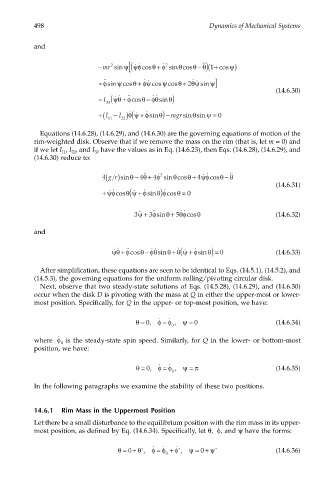Page 517 - Dynamics of Mechanical Systems
P. 517
0593_C14_fm Page 498 Tuesday, May 7, 2002 6:56 AM
498 Dynamics of Mechanical Systems
and
( [
θ
˙ ˙
−mr sinψψφ cosθ + φ 2 ˙ sin cosθ θ ˙˙ ( 1 )
− ) + cosψ
2
˙
ψ
+ sin cosθ φψ ψ + 2 ˙ sinψ ]
˙˙
φ
θψ
˙
+ ˙ cos cosθ
(14.6.30)
− ( ˙ ˙ + cosθ φθ sin ) θ
˙ ˙
˙˙
ψθ φ
−
I
33
˙
˙
θψ φ
θ
+(I − ) ( ˙ + sinθ ) − mgrsin sinψ = 0
I
11 22
Equations (14.6.28), (14.6.29), and (14.6.30) are the governing equations of motion of the
rim-weighted disk. Observe that if we remove the mass on the rim (that is, let m = 0) and
if we let I , I , and I have the values as in Eq. (14.6.23), then Eqs. (14.6.28), (14.6.29), and
33
22
11
(14.6.30) reduce to:
(
4 gr)sinθ − θ ˙˙ 4φ 2 ˙ sin cosθ + ψφ cosθ − θ
θ
4 +
4 ˙ ˙
˙˙
(14.6.31)
ψφ
+ ˙ ˙ cosθ ( ˙ ψ + sinφ ˙ θ ) cosφ ˙ θ = 0
˙ ˙
3 ˙˙ ψ + 3 sinθ + 5θφ cosθ (14.6.32)
φ
˙˙
and
˙ ˙ (
ψθ φ cosθ φθ− ˙ ˙ sinθ θ ψ φ ˙ sinθ) = 0 (14.6.33)
˙˙
˙ ˙
+
+
+
After simplification, these equations are seen to be identical to Eqs. (14.5.1), (14.5.2), and
(14.5.3), the governing equations for the uniform rolling/pivoting circular disk.
Next, observe that two steady-state solutions of Eqs. (14.5.28), (14.6.29), and (14.6.30)
occur when the disk D is pivoting with the mass at Q in either the upper-most or lower-
most position. Specifically, for Q in the upper- or top-most position, we have:
˙
˙
θ = 0, φ = φ , ψ = 0 (14.6.34)
0
where φ ˙ 0 is the steady-state spin speed. Similarly, for Q in the lower- or bottom-most
position, we have:
˙
˙
θ = 0, φ = φ , ψ = π (14.6.35)
0
In the following paragraphs we examine the stability of these two positions.
14.6.1 Rim Mass in the Uppermost Position
Let there be a small disturbance to the equilibrium position with the rim mass in its upper-
˙
φ
most position, as defined by Eq. (14.6.34). Specifically, let θ, , and ψ have the forms:
θ =+ θ , φ = φ + φ , ψ =+ ψ * (14.6.36)
˙
* ˙
˙
*
0
0
0

